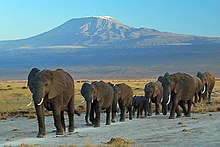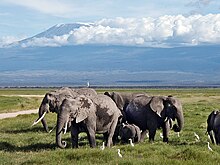Amboseli National Park: Difference between revisions
BhagyaMani (talk | contribs) →Wildlife: revised int link |
Rescuing 1 sources and tagging 1 as dead. #IABot (v1.6.1) (Balon Greyjoy) |
||
| Line 18: | Line 18: | ||
}} |
}} |
||
'''Amboseli National Park''', formerly '''Maasai Amboseli Game Reserve''', is in [[Kajiado County]], [[Kenya]]. The park is {{convert|39206|ha|km2 sqmi|0|}}<ref>{{cite web |url=http://sea.unep-wcmc.org/wdbpa/sitedetails.cfm?siteid=758&level=nat |title=World Database on Protected Areas: Amboseli Nationalpark |publisher=sea.unep-wcmc.org|accessdate=2008-07-28}}</ref> in size at the core of an {{convert|8000|km2|sqmi}} ecosystem that spreads across the Kenya-[[Tanzania]] border. The local people are mainly [[Maasai people|Maasai]], but people from other parts of the country have settled there attracted by the successful tourist-driven economy and intensive agriculture along the system of [[swamp]]s that makes this low-rainfall area (average {{convert|350|mm|in|abbr=on}}) one of the best wildlife-viewing experiences in the world with 400 species of birds including water birds, pelicans, kingfishers, crakes, hammerkops and 47 types of raptor.<ref>http://www.amboselinationalpark.co.uk/facts-about-the-amboseli-national-park/ Amboseli National Park</ref> |
'''Amboseli National Park''', formerly '''Maasai Amboseli Game Reserve''', is in [[Kajiado County]], [[Kenya]]. The park is {{convert|39206|ha|km2 sqmi|0|}}<ref>{{cite web |url=http://sea.unep-wcmc.org/wdbpa/sitedetails.cfm?siteid=758&level=nat |title=World Database on Protected Areas: Amboseli Nationalpark |publisher=sea.unep-wcmc.org |accessdate=2008-07-28 }}{{dead link|date=December 2017 |bot=InternetArchiveBot |fix-attempted=yes }}</ref> in size at the core of an {{convert|8000|km2|sqmi}} ecosystem that spreads across the Kenya-[[Tanzania]] border. The local people are mainly [[Maasai people|Maasai]], but people from other parts of the country have settled there attracted by the successful tourist-driven economy and intensive agriculture along the system of [[swamp]]s that makes this low-rainfall area (average {{convert|350|mm|in|abbr=on}}) one of the best wildlife-viewing experiences in the world with 400 species of birds including water birds, pelicans, kingfishers, crakes, hammerkops and 47 types of raptor.<ref>{{cite web |url=http://www.amboselinationalpark.co.uk/facts-about-the-amboseli-national-park/ |title=Archived copy |accessdate=2011-06-14 |deadurl=yes |archiveurl=https://web.archive.org/web/20110903215013/http://www.amboselinationalpark.co.uk/facts-about-the-amboseli-national-park/ |archivedate=3 September 2011 |df=dmy-all }} Amboseli National Park</ref> |
||
The park protects two of the five main swamps, and includes a dried-up [[Pleistocene]] lake and semi-arid vegetation. |
The park protects two of the five main swamps, and includes a dried-up [[Pleistocene]] lake and semi-arid vegetation. |
||
Revision as of 19:20, 20 December 2017
| Amboseli National Park | |
|---|---|
| Location | Kajiado County, |
| Nearest city | Nairobi |
| Coordinates | 02°38′29″S 37°14′53″E / 2.64139°S 37.24806°E |
| Area | 392 km2 (151 sq mi) |
| Established | 1974 as a national park (as a reserve in 1906) |
| Visitors | 120,000 (estimated) (in 2006) |
| Governing body | Kenya Wildlife Service, Olkejuado County Council and the Maasai community |
Amboseli National Park, formerly Maasai Amboseli Game Reserve, is in Kajiado County, Kenya. The park is 39,206 hectares (392 km2; 151 sq mi)[1] in size at the core of an 8,000 square kilometres (3,100 sq mi) ecosystem that spreads across the Kenya-Tanzania border. The local people are mainly Maasai, but people from other parts of the country have settled there attracted by the successful tourist-driven economy and intensive agriculture along the system of swamps that makes this low-rainfall area (average 350 mm (14 in)) one of the best wildlife-viewing experiences in the world with 400 species of birds including water birds, pelicans, kingfishers, crakes, hammerkops and 47 types of raptor.[2]
The park protects two of the five main swamps, and includes a dried-up Pleistocene lake and semi-arid vegetation.
240 kilometers (150 miles) southeast from the capital city Nairobi, Amboseli National Park is the second most popular national park in Kenya after Maasai Mara National Reserve.
History
In 1883, Joseph Thompson was the first European to penetrate the feared Maasai region known as Empusel (meaning 'salty, dusty place' in Maa). He, too, was astonished by the fantastic array of wildlife and the contrast between the arid areas of the dry-lake bed and the oasis of the swamps, a contrast that persists today.
Amboseli was set aside as the 'Southern Reserve' for Maasai in 1906 but returned to local control as a Game Reserve in 1948. Gazetted a National Park in 1974 to protect the core of this unique ecosystem, it was declared a UNESCO Man and the Biosphere Reserve in 1991. The park earned $3.5 m (€2.9 m) in 2005. On 29 September 2005, Kenyan President Mwai Kibaki declared that control of the park should pass from the Kenya Wildlife Service to the Olkejuado County Council and the Maasai tribe. Some observers saw this as a political favour in advance of a vote on a new Kenyan constitution: legal challenges are currently in court. The degazetting would divert park admission fees directly to the County Council with shared benefits to the Maasai immediately surrounding the park.
Wildlife


The park is famous for being the best place in the world to get close to free-ranging elephants.[3] Other attractions of the park include opportunities to meet Maasai and visit a Maasai village. The park also has views of Mount Kilimanjaro, the highest free-standing mountain in the world.
Amboseli was home to Echo, perhaps the most researched elephant in the world, and the subject of many books and documentaries, followed for almost four decades by American conservationist Dr Cynthia Moss. Echo died in 2009 when she was about 60 years old.
Amboseli offers some of the best opportunities to see African wildlife because the vegetation is sparse due to the long dry months. Amboseli National Park is home to many species, including African bush elephants, Cape buffaloes, impala, East African lions, cheetahs, spotted hyenas, Masai giraffes, plains zebras and blue wildebeest among other African animals. There is also a host of Kenyan birds, both large and small.[citation needed]
The park has several rules to protect the wildlife: never getting out of the vehicle, except at designated spots; no harassing the animals in any way; always keeping to the tracks; no off-road driving; and always giving the animals the right of way. The roads in Amboseli have a loose surface of volcanic soil that is dusty in the dry season and impassable in the wet season.[citation needed]
Access
There is a small airport in Amboseli, the Amboseli Airport (HKAM).
See also
References
- ^ "World Database on Protected Areas: Amboseli Nationalpark". sea.unep-wcmc.org. Retrieved 28 July 2008.[permanent dead link]
- ^ "Archived copy". Archived from the original on 3 September 2011. Retrieved 14 June 2011.
{{cite web}}: Unknown parameter|deadurl=ignored (|url-status=suggested) (help)CS1 maint: archived copy as title (link) Amboseli National Park - ^ "ATE – Amboseli Trust for Elephants". elephanttrust.org. Archived from the original on 16 February 2008. Retrieved 17 March 2008.
{{cite web}}: Unknown parameter|deadurl=ignored (|url-status=suggested) (help)
External links
- http://www.amboselinationalpark.co.ke/ official website for Amboseli National Park
- Amboseli- Africa's Elephant Park – The Official Guide
- Kenya Wildlife Service – Amboseli National Park

